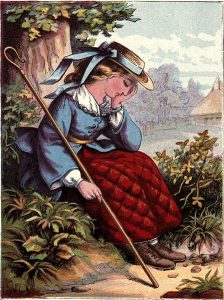 Little Bo Peep has lost her sheep
Little Bo Peep has lost her sheep
and doesn’t know where to find them.
Leave them alone and they’ll come home,
wagging their tails behind them.
I love nursery rhymes and fairy tales and, after doing a couple of design thinking activities with second grade with the fairy tale theme, decided to try something with first grade. While searching on the Teachers Pay Teachers site, I discovered STEM and Mother Goose: Nursery Rhymes with Engineering. After sharing the idea with the first grade teachers, I found that they had just finished a unit on nursery rhymes. Perfect timing! We chose “Little Bo Peep” primarily because we already had several of the materials.
However, when I asked the students who knew the Little Bo Peep rhyme, I was shocked that very few had heard of it! My boys grew up with nursery rhymes and fairy tales, but they are now in their thirties. I guess these aren’t as popular as in the past! Oh well, that didn’t stop the activity – I read the rhyme a couple of times and talked about poor Little Bo Peep who just couldn’t keep up with her sheep! We discussed what prototype meant and said that they’d be using straws, popsicle sticks, and/or coffee stirs to construct their model. Playdoh would be used to hold it together. The prototype would need to hold at least 6 cotton balls (which represented the sheep).
We used the The Launch Cycle model, developed by John Spencer and A.J. Juliani as our design thinking guide. I asked the students to first think what Little Bo Peep needed to keep her sheep in one spot. This was so hard because the children wanted to draw and discuss immediately. Think time was short; less than a minute for this age. Next, I asked the children to draw their ideas on paper; again without talking.

Finally, students were allowed to discuss and improve on their ideas. Lots of talking and hand motions occurred as they really got into the planning stage! Then, the materials were chosen and the building began.
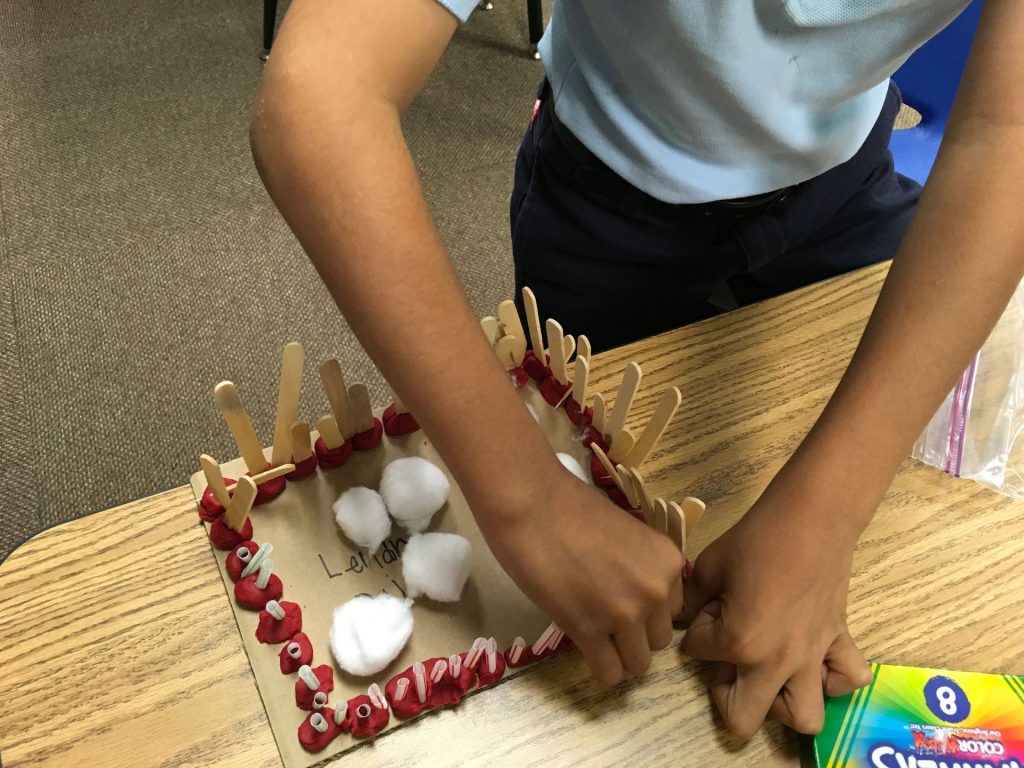
As we walked around the room, listening to the conversations, we heard fantastic collaboration and encouragement.
“Don’t lose confidence,” said one child to another when frustration was expressed.
Another group was asked by their teacher if the sheep could hop out of the low pen. In an exasperated voice, the makers replied, “No! It’s a protype!” She almost got the new vocabulary word – prototype!
Another group was describing their structure and the girl started with, “Well, Mary Bo Peep needs a pen because she keeps losing all her sheep.” Love the combination of nursery rhymes!

We didn’t finish the first week but that was fine. The following week, the children were SO excited to return to the lab to get their pen built. In the second session, I also asked the kids to take a photo in the Seesaw app and record something about their design.

Sometimes we’re hesitant to try design thinking activities with our younger students. After watching the collaboration and listening to the conversations, I’m convinced this is a vital part of learning. These children AMAZED me! Is it messy? Oh, yes! Is it worth it? Definitely!!
Links for other class videos:
Mrs. Crumley’s video
Mrs. Hutchinson’s video
Sra. Ross came to me a few weeks ago asking about an app for her second grade students to record themselves speaking Spanish as they described photos. She wanted to share the videos with parents so they could hear what their children are learning in class.
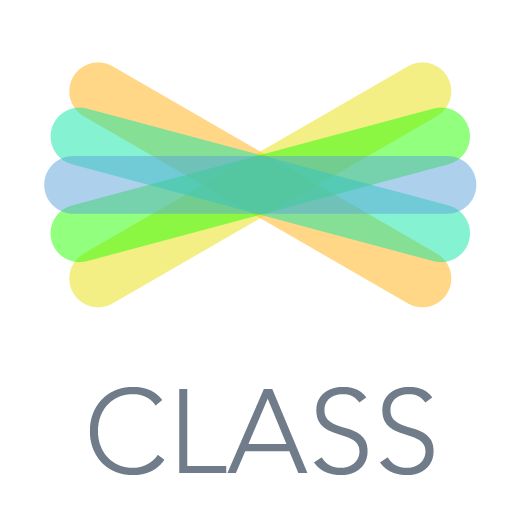 We’ve been using Seesaw, a digital portfolio, with our 1st and 2nd graders so we knew that was an excellent way to share the finished work. The next question was how to combine the photos with their narration.
We’ve been using Seesaw, a digital portfolio, with our 1st and 2nd graders so we knew that was an excellent way to share the finished work. The next question was how to combine the photos with their narration.
 Fortunately, I’ve been following the Seesaw group on Facebook and have learned SO much! Having read how child-friendly the Shadow Puppet EDU app was, I suggested using that. Let me tell you – this has become one of my ALL-TIME favorite apps! It’s a really easy way to combine 2 or more images, narrate, then save as a video to the camera roll. It also uploads seamlessly to Seesaw (app is created by the Seesaw developers).
Fortunately, I’ve been following the Seesaw group on Facebook and have learned SO much! Having read how child-friendly the Shadow Puppet EDU app was, I suggested using that. Let me tell you – this has become one of my ALL-TIME favorite apps! It’s a really easy way to combine 2 or more images, narrate, then save as a video to the camera roll. It also uploads seamlessly to Seesaw (app is created by the Seesaw developers).
Back to Spanish – Sra. Ross and her co-teacher, Sra. Sanders, took the second graders to the playground where they photographed equipment. They asked me to help guide the students as they created their video. Students added their photos, recorded themselves talking about the equipment, and some even wrote the vocabulary or the phrase in Spanish. The videos were uploaded to their Seesaw portfolio. What a great way to share a foreign language with parents!
Students are unable to access their files and can’t work on what you had planned? Last night, we had an email warning that desktop folders had disappeared. Well, 4th graders have been working on self-portraits using MS Paint and they were unable to access them.
Perhaps that’s one reason I couldn’t fall asleep last night – my mind was working overtime to figure out the best thing to do with the students. Design thinking was at the forefront of ideas but what supplies did I have at school? That’s a bit hard to determine at 2:00 AM!
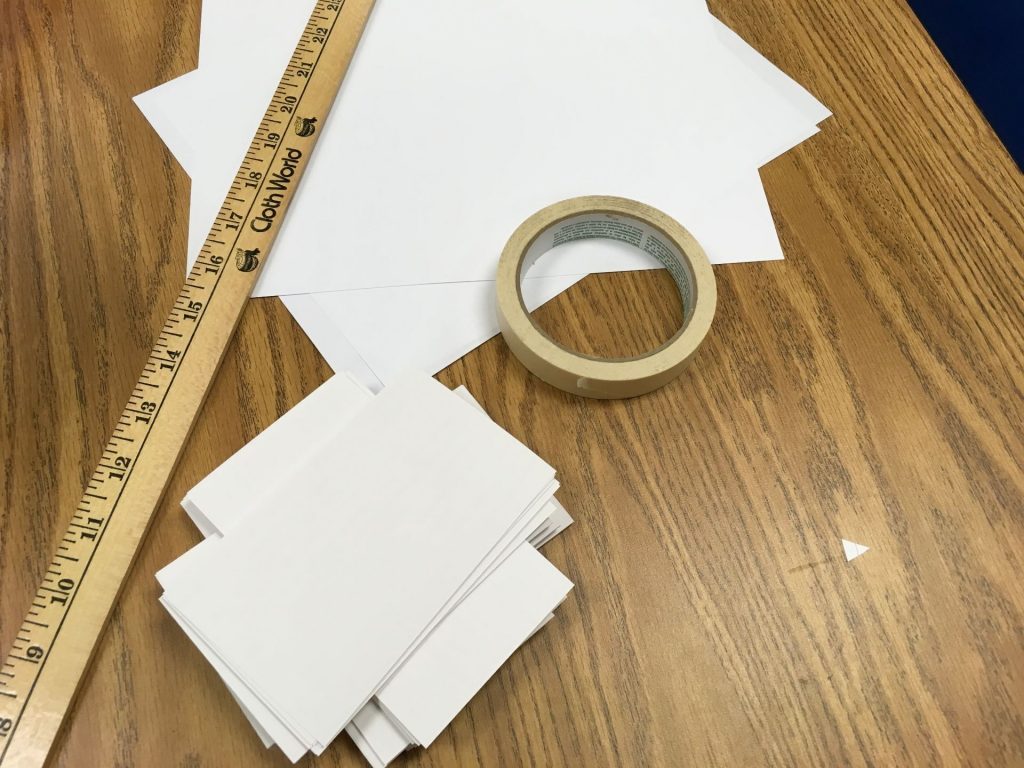
Index cards and masking tape turned out to be plentiful so that’s what we went with!
Challenge:
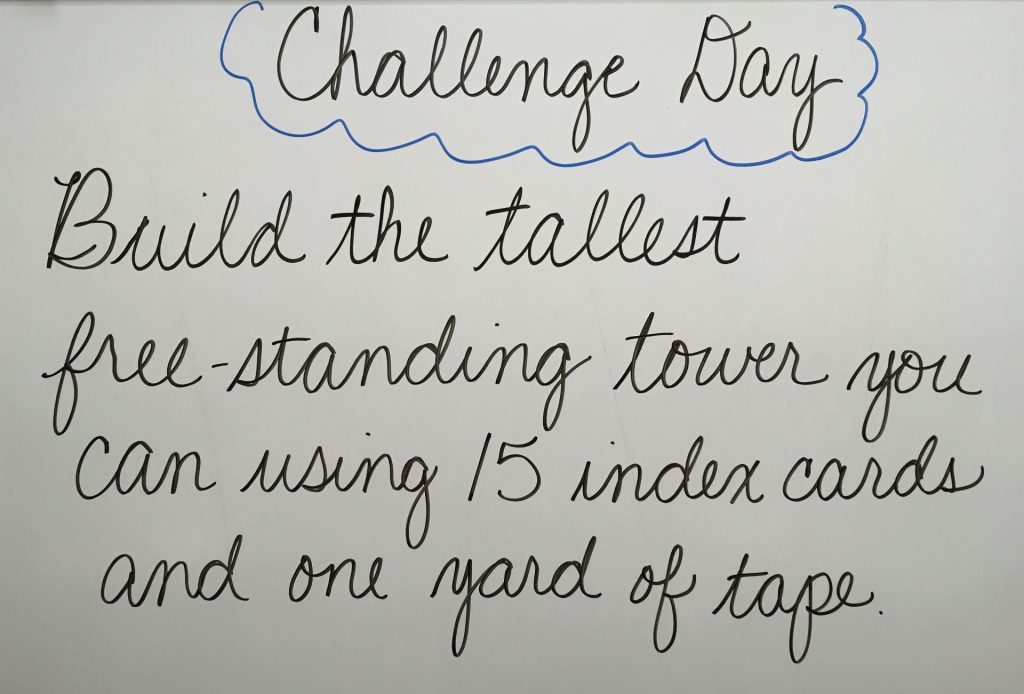
This changed over time after getting feedback from each group. The first group worked with only a half yard of tape. At the end of class, I told them they were my test group and I needed feedback for the other two classes. All agreed more tape was needed. The biggest request was duct tape, along with moans and groans that the masking tape wasn’t sticky AT ALL! Oh well, you work with what you have!
Using the Launch Cycle as a guideline, students were given one minute to listen to ideas from their group. Next, one minute to sketch ideas – no talking.
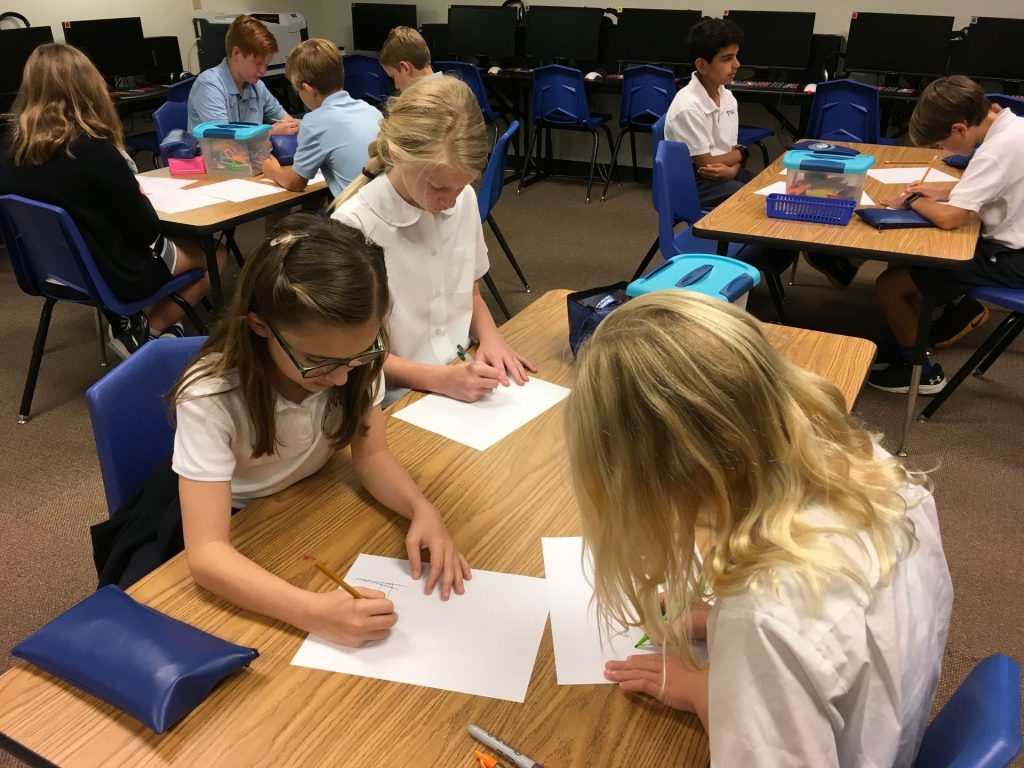
Then, another minute to decide how to incorporate designs into one to be used for the creation stage.
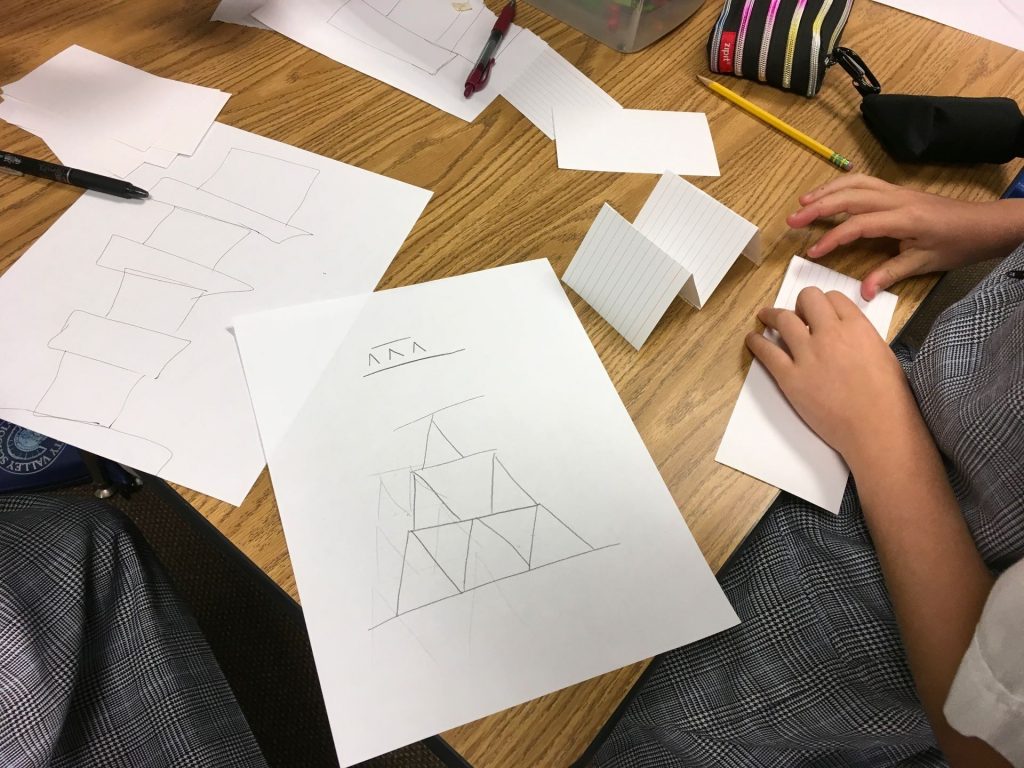
Yes, they were moved quickly through the process but I only have them for 30 minutes!
Building began and we had a huge variety of structures – some worked, others didn’t. Of course, the tendency for students is to build the highest structure possible without regard as to whether or not it can stand on its own! There were several “Leaning Towers of Pisa!”
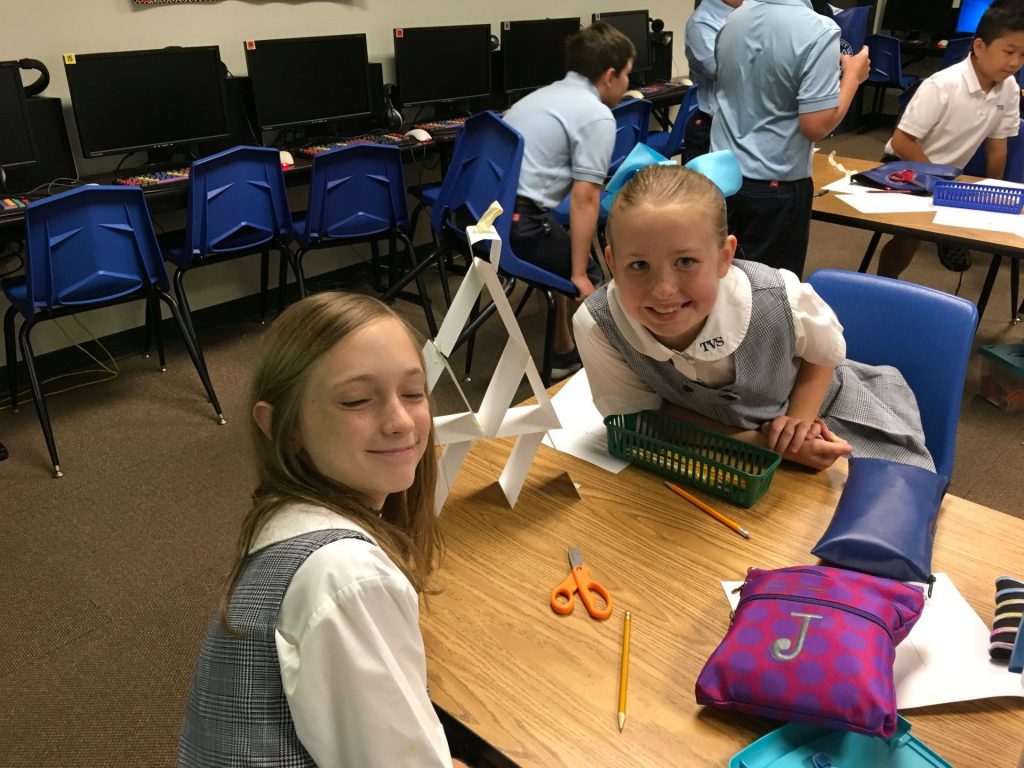
The above pair worked so quietly and methodically, no one heard a peep out of them! The group below built straight up but definitely had a plan. One member kept his group on track with constant reminders “that the base has to be propped up.”
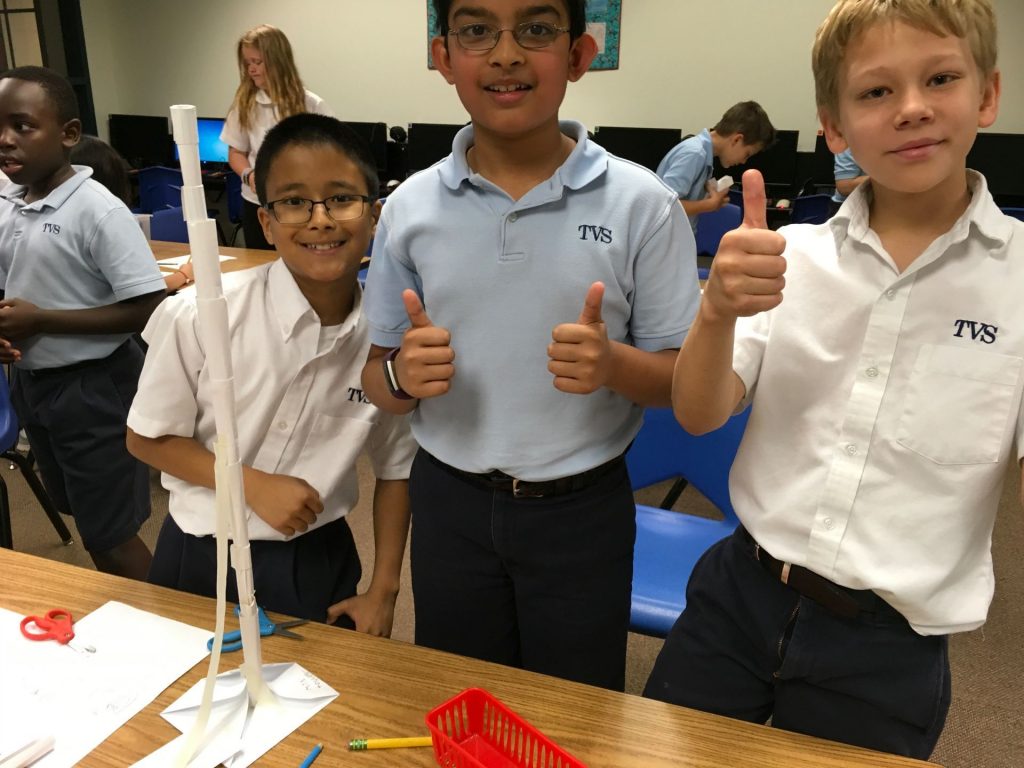
As we reflected, we talked about success and failure. Did the building proceed according to their sketches? What adjustments were made? Did you give up if something didn’t work the first time? (Yes, some groups did!) I even told the students that in an activity like this, failure was expected. Why? That’s the best way to learn!
Was it loud? YES!! Much louder that I like but every single person was on task. What I liked was watching students who are usually quiet or who don’t always feel secure in answering questions in front of the class, absolutely blossom in this environment! Will we do this again? You bet!
And, to think, not one child asked why we weren’t using technology in the tech lab!!
 Our kindergarteners presented their spring play last week and this year they performed The Great Fuzz Frenzy, based on a book by the same name. This is a cute story about a tennis ball that a dog has dropped into a prairie dog tunnel. The prairie dogs are terrified at first then they decide the ball’s fuzz is fun to have. If you haven’t read this book, be sure to do so to find out what happens in the end.
Our kindergarteners presented their spring play last week and this year they performed The Great Fuzz Frenzy, based on a book by the same name. This is a cute story about a tennis ball that a dog has dropped into a prairie dog tunnel. The prairie dogs are terrified at first then they decide the ball’s fuzz is fun to have. If you haven’t read this book, be sure to do so to find out what happens in the end.
When the students came to the lab, I wanted them to illustrate a favorite part of the play and record a sentence or two about it. As I considered apps to use to accomplish this, I immediately thought of Book Creator, my favorite app because it can do so much, plus it is intuitive for even the youngest children.
Since we only have a 30 minute lab time, I did some prep work before the children arrived. A template was created in Book Creator and air dropped to each iPad. I used the landscape shape so there would be plenty of room for drawing. I also went in to each iPad to name the books with teacher & student name. That is a huge help to me when the books are air dropped to my iPad from three different classes. It makes it SO much easier to combine them into each class book.
 We haven’t used Book Creator with kindergarten but with just a few tips, the children were busy with their illustrations. As they begin to finish the drawings, I showed them how to record. I just love how this child became swallowed up by the recording cube!
We haven’t used Book Creator with kindergarten but with just a few tips, the children were busy with their illustrations. As they begin to finish the drawings, I showed them how to record. I just love how this child became swallowed up by the recording cube!
 For one of the kinder classes, we were able to have a roomful of eager second grade mentors! What a wonderful help they were! The older students were paired with one or two kindergarteners and they did such a fantastic job guiding them through the drawing and recording steps.
For one of the kinder classes, we were able to have a roomful of eager second grade mentors! What a wonderful help they were! The older students were paired with one or two kindergarteners and they did such a fantastic job guiding them through the drawing and recording steps.

 By the end of each 30 minute session, every student had completed their page of the book.
By the end of each 30 minute session, every student had completed their page of the book.
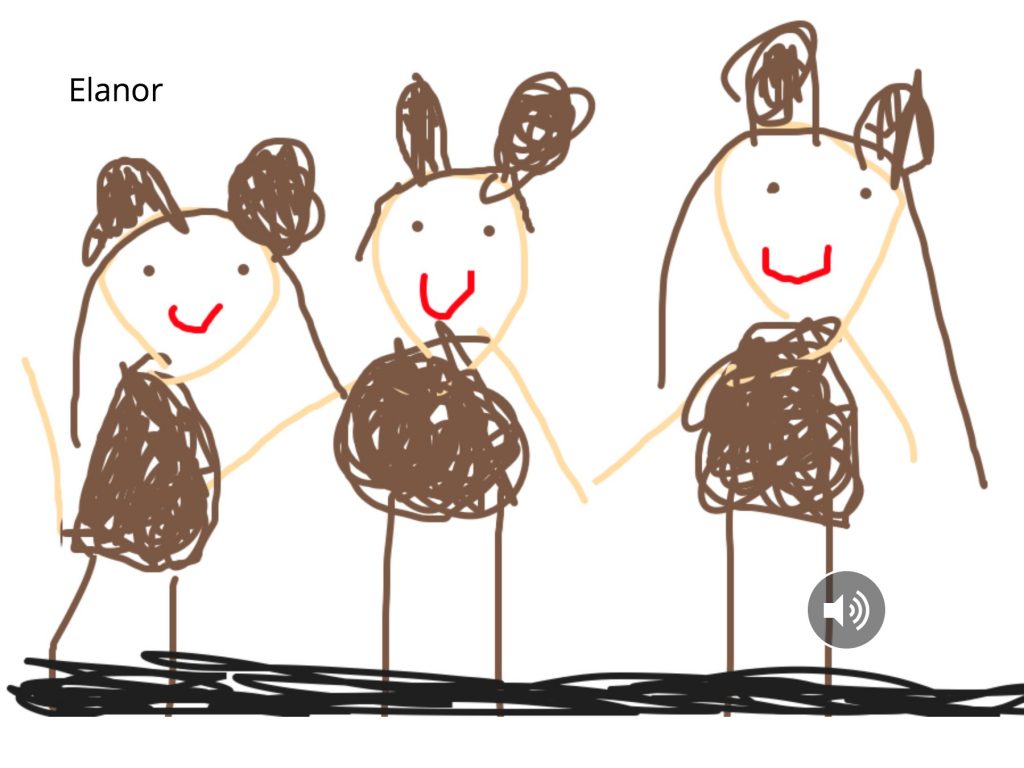
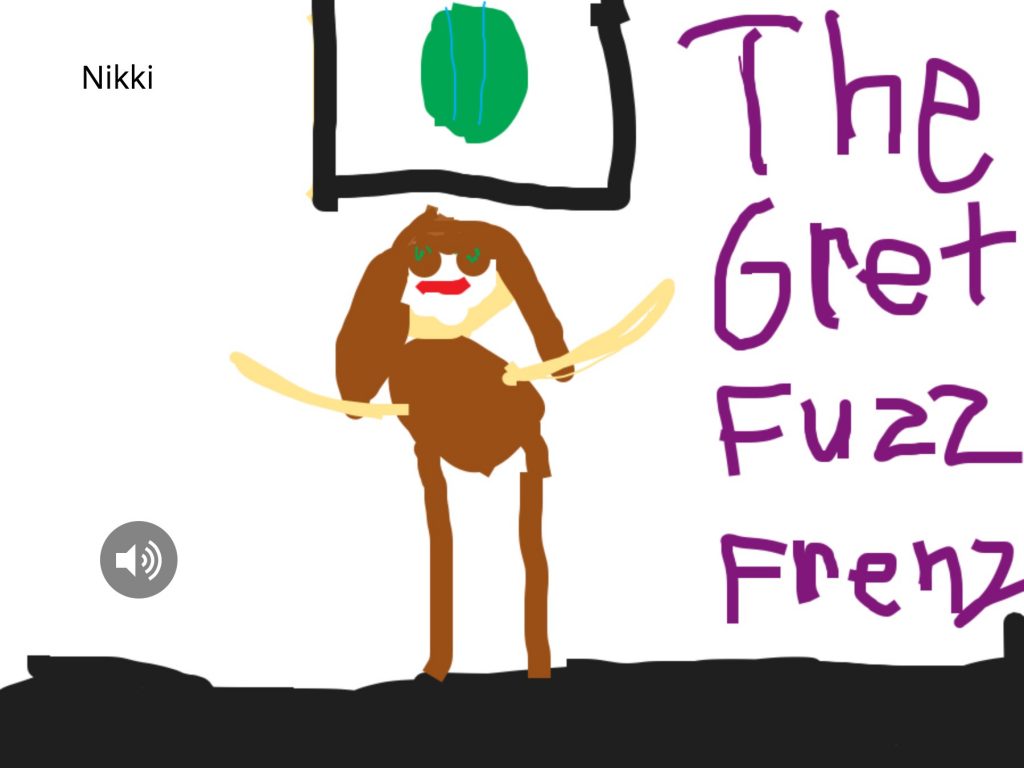 I knew the app would be perfect for this age; just didn’t know if we’d have enough time. Are the recordings perfect? No, some are too soft; others have a lot of background noise. Is that acceptable? Yes! The children were learning as they created something that was very special to them.
I knew the app would be perfect for this age; just didn’t know if we’d have enough time. Are the recordings perfect? No, some are too soft; others have a lot of background noise. Is that acceptable? Yes! The children were learning as they created something that was very special to them.
Here’s a video of one of the books (Mrs. Newton’s class):
Save
Save
Links to the ePub books:
While on an iOS device that has the iBooks app installed, tap on a link. Choose download > open in iBooks.
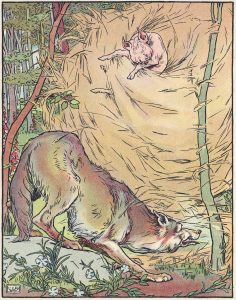 Continuing with the Fairy Tale theme, Mrs. Garcia and I found an activity from Teachers Pay Teachers called, The Big Bad Wolf STEM Challenge. We adapted it slightly to incorporate design thinking. (I like to use the Launch Cycle model because it’s very easy for elementary children to understand. See the post, Design Thinking + Dot Day = Thoughtful Creation, for a more in-depth description of this model.)
Continuing with the Fairy Tale theme, Mrs. Garcia and I found an activity from Teachers Pay Teachers called, The Big Bad Wolf STEM Challenge. We adapted it slightly to incorporate design thinking. (I like to use the Launch Cycle model because it’s very easy for elementary children to understand. See the post, Design Thinking + Dot Day = Thoughtful Creation, for a more in-depth description of this model.)
 The challenge: Build a house for the pigs that can’t be blown down by the Big Bad Wolf (aka the hairdryer).
The challenge: Build a house for the pigs that can’t be blown down by the Big Bad Wolf (aka the hairdryer).
The students chose 20 of one of the following:
- toothpicks
- straws
- popsicle sticks
We started by asking the children to assume the role of the pigs. What would you want for a house? How could it be built so that it was sturdy enough to withstand all the huffing and puffing of the wolf?
Going through the design thinking process, we had the students discuss ideas with their partner using only verbal descriptions. They had 2 minutes for this (and begged for more)! Then, the children sketched ideas based on the previous discussions. Next, each described their illustrations. The hardest task was to choose the “final” design – the one to be used for building. That step required give and take as well as negotiating skills as they tried to prove that certain designs would withstand the wolf better than others. It was interesting to listen to the conversations as the children combined the best parts of each of the sketches. There was no arguing. Instead, we saw and heard fantastic reasoning skills as students talked through the pros and cons of each design element!

Time for building! Students collected the materials and went to work. No two houses were alike!

The one thing I’d change for the future would be to limit the amount of tape. That would certainly increase the challenge difficulty. These houses were like an armored truck; there was SO much tape wrapped around some of them that I’m not even sure these structures could be crushed!

The reflection time is very important. It’s really easy to skip this step because of lack of time but it’s critical to have the students talk about their challenges; what worked, what didn’t, what they would change doing it again, etc. It also provides the opportunity for the teacher to get a better idea of the students’ thinking.
Here’s a video to give you a glimpse into the Three Pigs challenge.
To the students, this seems like “play” – it’s most definitely fun for children AND teachers! But, there is SO much learning going on. Collaboration, design, planning, learning how to improvise if something doesn’t work – to name just a few of the skills!
I’d love to hear your experiences with design thinking!
The second grade classes are reading Stuart Little this year. After attending the LLI Southwest conference in February, our teachers are eager to incorporate design thinking and makerspace activities into their curriculum. One of our teachers, Mrs. Shapard, came to me with the idea of having her students create a small room to better fit Stuart Little. We brainstormed materials that might be helpful for students to use and she asked parents to send in anything that might be useful for the project. Soon, her room was filled with boxes, empty paper towel/toilet paper rolls, fabric scraps, buttons, small plastic bottles, and much more.
 I really like Launch Cycle by John Spencer and AJ Juliani to move the students through the design thinking process. “Launch” is an acronym that describes each step in the process. I also like the cycle image so that students have a great visual showing planning and creating as a continuous process.
I really like Launch Cycle by John Spencer and AJ Juliani to move the students through the design thinking process. “Launch” is an acronym that describes each step in the process. I also like the cycle image so that students have a great visual showing planning and creating as a continuous process.
Empathy is a critical part of the process and this is a challenge for any age, especially for younger children who like to create something based on their likes. The challenge was to think like Stuart Little. What would he like in his room? We started with a thinking time about a minute long. That seems like an eternity for students who are ready to build!
We talked about architects and builders; how they would never start to build something without having plans first. One of the parents in this class is a builder so the child knew exactly what I was talking about and eagerly explained it to her peers.
 As we began, I first asked the students to get some ideas in their head. No drawing yet! After a long minute, we moved to the next step which was to sketch out their ideas for the room. Again, I just gave them a short time (a couple of minutes). There were lots of groans and comments that it was TOO short!
As we began, I first asked the students to get some ideas in their head. No drawing yet! After a long minute, we moved to the next step which was to sketch out their ideas for the room. Again, I just gave them a short time (a couple of minutes). There were lots of groans and comments that it was TOO short!
 Before we moved on to the next part, we discussed how to disagree without hurting anyone’s feelings. This step involved telling about the ideas and then deciding which to use. We stressed that parts of each sketch could easily be incorporated into the chosen design. Then the chatter between each pair of students began. We loved hearing the respectful way that each child listened. They truly wanted to hear about their partner’s ideas.
Before we moved on to the next part, we discussed how to disagree without hurting anyone’s feelings. This step involved telling about the ideas and then deciding which to use. We stressed that parts of each sketch could easily be incorporated into the chosen design. Then the chatter between each pair of students began. We loved hearing the respectful way that each child listened. They truly wanted to hear about their partner’s ideas.
The next step – building! The children were SO excited! As we walked around observing and asking questions, we learned more about the thinking processes of the children. And, that was fascinating! One boy told us that he couldn’t find the supplies that they wanted to use for their room so they “had to start from scratch.” No complaining about lack of supplies, he and his partner solved that roadblock and moved on!
Here’s a video to show the students in action.
After about 30 minutes, Mrs. Shapard had to send the students to Spanish. The students had additional time later that day and into the next. At that point, the students were told building would end that day. Later, I saw Mrs. Shapard who told me that the students were mad at her. When asked why, she reported that they weren’t at all ready to stop!
At our reflection meeting, I asked the students to tell me how they felt about the designing and building. Here are some responses:
- It was hard getting an idea and then choosing which one to build.
- We had trouble getting things to stick together so maybe the supplies weren’t the best.
- It was easier to draw the design on the paper than it was to build it when you found out you didn’t have the right materials.
- It’s going to be hard to decide who keeps what we built.
- We couldn’t find one of the supplies that we’d used earlier so we had to find something else and make it work.
- My partner did a lot of compromising with me.
- It was hard agreeing where to place things.
As for the teacher reflection, we decided that perhaps the challenge was too open-ended and really couldn’t be completed in a reasonable amount of time. Next time we’ll narrow the focus. Regardless, the planning, designing, communicating, and compromising that occurred was well worth it!
I love the story of Flat Stanley – the boy who ended up flattened when his bulletin board fell on him! The book explores the many benefits to being flat!
Mrs. Zabriskie, one of our second grade teachers, wanted to create a design thinking lesson where her students would create something that would protect Stanley from falling bulletin boards.
 I used the Launch Cycle by John Spencer and AJ Juliani to move the students through a design thinking process. We began by just thinking about what might work for Stanley – and, let me say that it is hard to sit in complete silence for 60 seconds! Actually, I shortened it to 40 seconds which, as one student said, “Seemed like forever!”
I used the Launch Cycle by John Spencer and AJ Juliani to move the students through a design thinking process. We began by just thinking about what might work for Stanley – and, let me say that it is hard to sit in complete silence for 60 seconds! Actually, I shortened it to 40 seconds which, as one student said, “Seemed like forever!”
After that, time moved too quickly (according to students!). First, I asked the students to talk about ideas they had to keep Stanley safe. They had 2 minutes for this and everyone in the group had the opportunity to speak and ask questions. When the timer went off, there were lots of groans along with, “That couldn’t have been 2 minutes!”
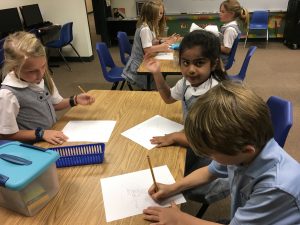 Next, the students were asked to sketch of what they could create to keep Stanley safe. No talking for this segment; that came in the next step. After a couple of minutes sketching, the children shared the drawings with their group. The most difficult part was deciding which design would be used for the prototype. We role-played how to disagree nicely as well as how to take some aspects from each sketch to create a working design.
Next, the students were asked to sketch of what they could create to keep Stanley safe. No talking for this segment; that came in the next step. After a couple of minutes sketching, the children shared the drawings with their group. The most difficult part was deciding which design would be used for the prototype. We role-played how to disagree nicely as well as how to take some aspects from each sketch to create a working design.
We enjoyed listening to the children as they participated in that all-important give and take; such an important skill to learn. Lots of hand gestures were observed as students attempted to explain their ideas to the group.
As for materials, Mrs. Zabriskie asked for parents to send in straws, paper towel rolls, toothpicks, playdoh, etc. I believe she bought a few items as well. Really, anything can be used.
I wasn’t able to participate in the entire building process since I had another class to teach. From comments from the teacher and the students, this was a worthwhile activity. The students didn’t think they were doing “school stuff” but, in reality, they were learning many important life skills:
- problem-solving
- sharing
- communication
- reasoning
- failure
Yes, even failure! Two major goals of design thinking are for children to practice empathy as they work on problems to solve that help someone else (in this case, a book character) and to discover that failure isn’t a bad thing; that we take failures and learn from them.
A few days after the project, I asked the students to blog about the process. Here are just a few of the responses.

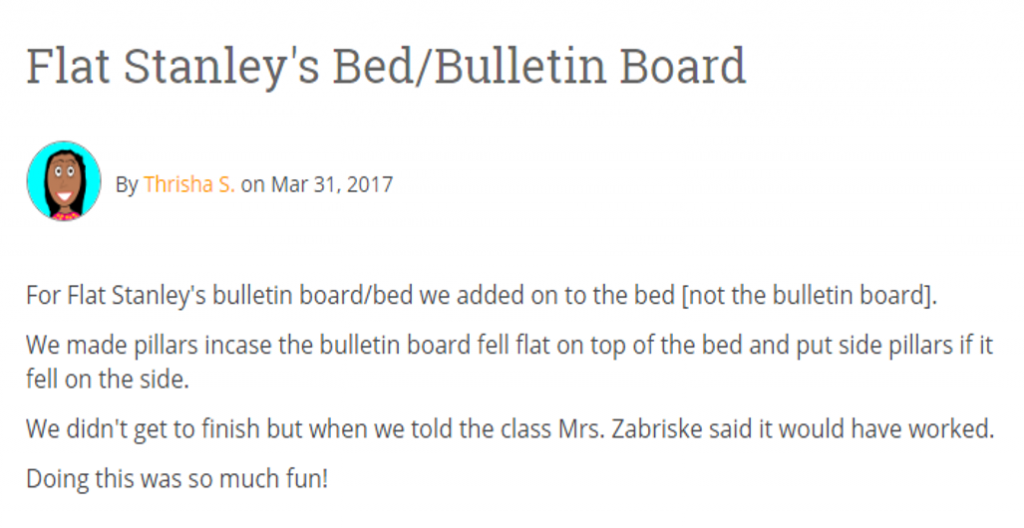
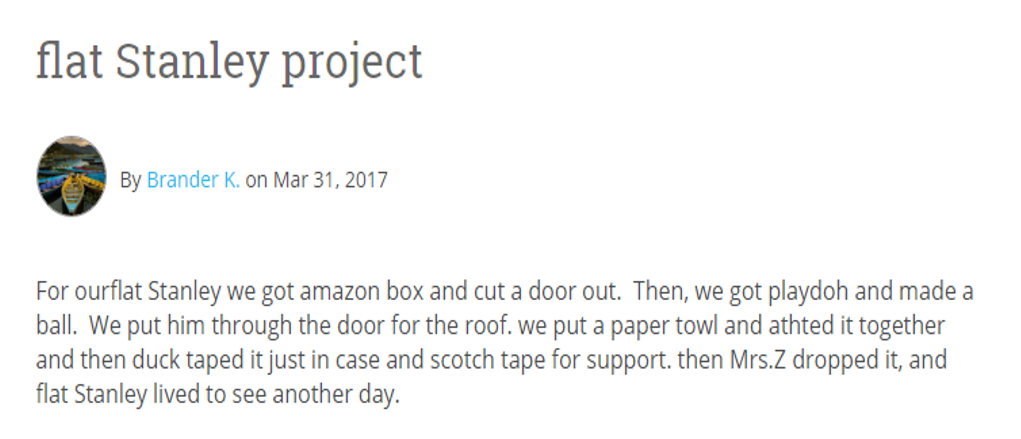
Every year our Parents’ Club has either an auction or a gallery night to raise money for educational projects. Teachers generally submit an activity for bidding. I’ve been doing a “TechnoWizards Club” for the past few years. Last week, six students joined me as we worked with Ozobots, Ollie robots, and Little Bits magnetic circuits.
We met for an 1 1/2 hours, which is never enough! Regardless, it was loads of fun to watch the children experiment with the different activities.
Here’s a look at what we did:
Mrs. Garcia, one of our second grade teachers, approached me to ask if we could do a design thinking/STEM activity that related to fairy tales. We brainstormed a list of tales that she wanted to present to her children and decided on 2 or 3 that we would use for the design thinking activities.
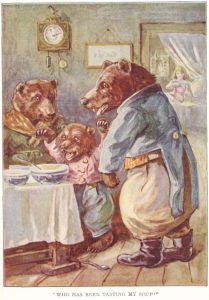 We started with Goldilocks and the Three Bears since it’s such a familiar story. On TeachersPayTeachers, I found a fun STEM activity where students build a latch for the 3 bears. This, combined with the Design Thinking “Launch” cycle, made for a really fun and productive morning!
We started with Goldilocks and the Three Bears since it’s such a familiar story. On TeachersPayTeachers, I found a fun STEM activity where students build a latch for the 3 bears. This, combined with the Design Thinking “Launch” cycle, made for a really fun and productive morning!
The challenge: Build a latch for the three bears’ house that will prevent anyone from breaking in.
We discussed how designers, architects, builders, etc. work from written designs or blueprints. What would happen if a builder decided he didn’t need to follow a design; that he could work with just the idea in his head? Of course, the students could picture all kinds of ways that this would be a lousy idea! Then, we talked about what a latch is – not a very common word these days!

Following the Launch acronym, I asked the students to think like one of the three bears (empathy). How would you feel if someone entered your house without permission? Working in pairs, the children were given two minutes to talk about how they envisioned the latch would work. The hardest part of this particular part was not drawing! Only words (and lots of hand motions) were allowed! When the timer went off, there were lots of “Wait! We haven’t finished talking!”
 Next, the students drew designs. Again, a short time was given for sketching 2 or 3 ideas. Then, the hard part . . . deciding which design to use OR deciding how to incorporate elements from a few of the designs.
Next, the students drew designs. Again, a short time was given for sketching 2 or 3 ideas. Then, the hard part . . . deciding which design to use OR deciding how to incorporate elements from a few of the designs.
Only after all these steps were the students ready to construct! Supplies we used:
- craft sticks
- pipe cleaners
- masking tape
- straws
- water bottle caps
Before collecting supplies, the children were to make a list of what they thought they would need. We did let them come back for more if needed.
As they built, we walked around to listen to the conversations and to ask questions. Listening to the students was an eye-opener! We were floored by the depth of their discussions as they built! And, it was amazing to watch them revise when they discovered kinks in their planning.

When all prototypes were completed, we came back together to share – not just describe the latch they built and how it worked. More importantly, we wanted to hear how the children handled ideas that didn’t work. Were you frustrated? Did you feel like giving up? What would you change in your design if you did this again?
Here’s a video of the students creating their latch.
Garcia_A Latch to Keep Goldilocks Out from Trinity Valley School on Vimeo.
This was so much fun! The best part for me was observing – I was absolutely amazed at the conversations and the complexity of the language that was heard!
I know children learn best through exploration, but sometimes it’s easy to forget how much they really can do on their own when we give them a challenge with no right or wrong answer. That’s when students really shine!
I’m not sure why but I hadn’t pulled out the Ozobots for the fourth graders this year so when they arrived at the lab and discovered Ozobots set out, they could hardly sit still to get instructions!
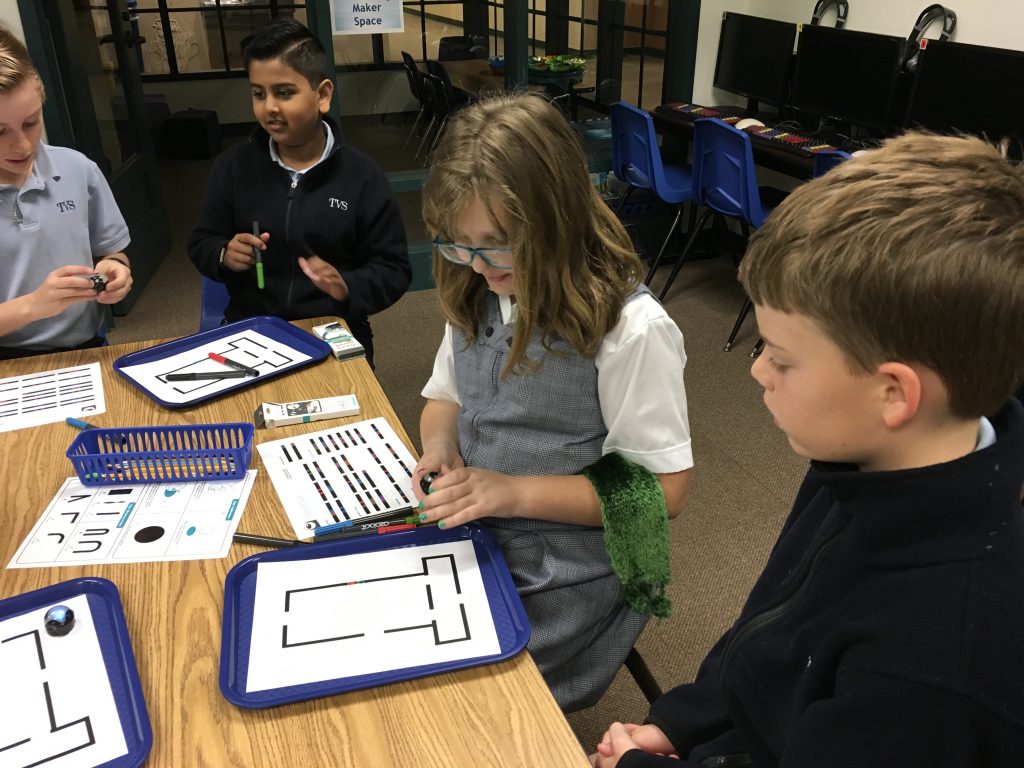 Needless to say, I presented the instructions in record time! Their job – add color codes and paths to the outline of the Cat in the Hat’s hat. iPads were set out so students could video their Ozobots. A few did that and then air dropped video to me so that I could add to what I took. Here’s a glimpse at what happened.
Needless to say, I presented the instructions in record time! Their job – add color codes and paths to the outline of the Cat in the Hat’s hat. iPads were set out so students could video their Ozobots. A few did that and then air dropped video to me so that I could add to what I took. Here’s a glimpse at what happened.
4th, Seuss & Ozobots from Trinity Valley School on Vimeo.
I would hear groans from students who couldn’t get their Ozobot to follow the code they thought they’d drawn. Then, I’d hear from someone else who announced that their code worked and they were more than happy to share tips on how to better draw effective codes.
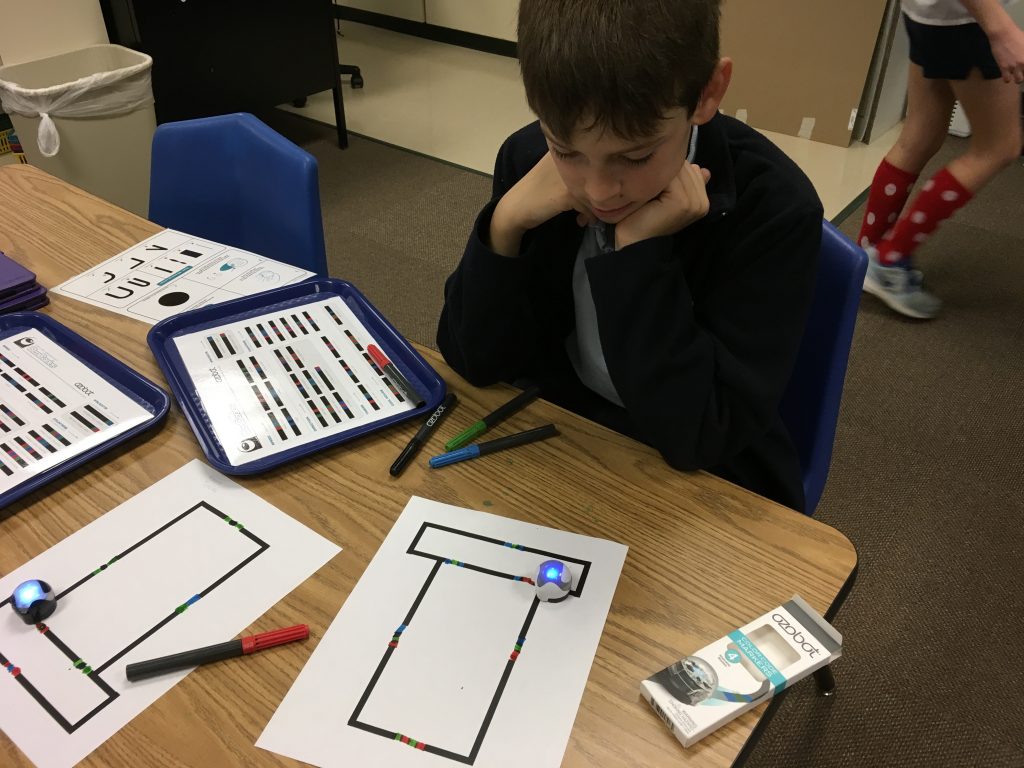 Lesson learned for me – I need to do MUCH more of the exploration time for the students. Yes, there are times when I need to do direct instruction but watching the fourth graders interact reminded me how important it is to allow time for uninterrupted learning to occur.
Lesson learned for me – I need to do MUCH more of the exploration time for the students. Yes, there are times when I need to do direct instruction but watching the fourth graders interact reminded me how important it is to allow time for uninterrupted learning to occur.
Save
 Little Bo Peep has lost her sheep
Little Bo Peep has lost her sheep


































